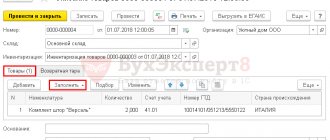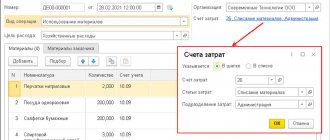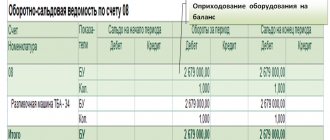If the received equipment requires preliminary assembly before being used for its intended purpose, then account 07 “Equipment for installation” is used to account for it.
This account is used by developers who purchase equipment for its further installation and fastening in a construction project under construction or renovation . The debit collects the costs incurred during the acquisition of equipment; from the credit, the amount of all costs is written off to account 08 to complete the installation procedure or to other types of accounts upon disposal as a result of write-off, sale, or gratuitous transfer.
When filling out the annual balance sheet, if there is a debit account balance 07, it is taken into account as part of field 1150 (fixed assets).
| ★ Best-selling book “Accounting from scratch” for dummies (understand how to do accounting in 72 hours) > 8000 books purchased |
What is taken into account on account 07
It is necessary to record on account 07 only that equipment for which, before putting it into operation, it is necessary to assemble its components and attach it to load-bearing structures - the floor, foundation, supports. Account 07 is only active.
This can be equipment of a technological, production, energy nature, as well as equipment used in workshops and laboratories during the construction of a new construction project or modification of an existing one.
It also takes into account sets of spare parts for such equipment, various control, measuring and other instruments installed in the mounted equipment.
Account 07 does not take into account objects that do not require assembly before being used for their intended purpose: (click to expand)
- Various types of transport;
- Machines that are integral structures;
- Mechanisms for construction purposes;
- Agricultural machines;
- Tool;
- Manufacturing equipment;
- Devices not related to the components of the mounted object.
The above assets should be accepted immediately through account 08 in the form of fixed assets to the debit of account 01, bypassing account 07.
Acceptance of equipment for registration
After registration of receipt, the equipment must be taken into account.
From the same section, go to the document list form “Acceptance for accounting of fixed assets” and click the “Create” button.
Let's start filling out the document details:
- “OS event” – we indicate how we will accept the equipment for accounting, with commissioning or not. Affects generated wires
- “MOL” – indicates the materially responsible person to whom the equipment will be assigned
- “Location of OS” – the division for which equipment will be recorded
Let's move on to the tabular part. The first tab is “Non-current asset”. Here you need to indicate the type of operation, the method of receipt and select from the “Nomenclature” directory the equipment that was installed at the arrival:
On the “Fixed Assets” tab, select an equipment card, which must first be entered into the “Fixed Assets” directory.
This directory stores all information about fixed assets. For the most part, the equipment card is filled out automatically when you post this document. It stores information about the initial and current cost of equipment, accrued depreciation, and reference information. The data is taken from the document. When a document is changed, the data in the directory also changes.
On the “Accounting” tab, we indicate which method will be used for depreciation and the period over which the equipment should be depreciated. The depreciation account is usually 02.01. Equipment account – 01.01:
If the company pays income tax, the “Tax Accounting” tab is also filled out. As a rule, it contains the same values as in the previous tab.
Let's run the document and see what transactions it generated in 1C 8.3:
It can be seen that the equipment was registered on account 01.01.
Receipt of equipment for installation
Possible receipt at the time of purchase, in the form of a free gift or through a contribution to the capital of the company. All costs that the company incurs in this case are recorded in debit 07. Their amount determines the actual cost of the purchased equipment that needs installation.
This cost includes:
- The price of the components of the equipment indicated in the attached accompanying documentation (agreement, invoice, act);
- Costs of delivering valuables to the warehouse;
- Setup and storage costs;
- % on loans received to pay for the cost of components of equipment;
- Expenses of an accountable person purchasing equipment independently;
- Other costs.
Organization of accounting
The amount of costs included in account 07 consists of:
- equipment prices;
- the cost of its delivery;
- storage and installation costs.
Subsequently, the cost of setting up and bringing the equipment to working condition is added to the expense item. In the organization's balance sheet, the above-described expenses are recorded as non-current assets on line 1190. Equipment not transferred for installation is reflected in line 1150 as part of the organization's fixed assets.
Using account 07, only equipment that requires installation and fixation is accounted for. These are all kinds of devices and equipment attached to the foundation of the building, floor, ceilings, as well as its components. Account 07 does not take into account vehicles, machines, tools and other mechanisms that do not require mandatory securing.
The cost of purchasing and installing equipment is usually reflected using the established forms OS-14 and OS-15, respectively. In case of equipment breakdown, accounting is carried out according to the OS-16 form. When filling them out, the details described in the federal law “On Accounting” are used. However, it is worth noting that organizations have the right to use independently developed and approved forms.
Taxation is carried out in accordance with Article 346.16 of the Tax Code of the Russian Federation. It states that the initial cost of depreciable property consists of the costs of purchasing and assembling equipment. Thus, tax accounting is carried out simultaneously according to the general and simplified systems.
Postings to the debit of account 07
When the equipment components are received at the warehouse for installation, entries are made to reflect all expenses incurred by the company. These expenses are reflected in debit 07 in correspondence with accounts, the type of which depends on the method of receipt of equipment to the enterprise.
Cost accounting entries in relation to purchased equipment requiring installation or assembly are carried out on the basis of the relevant documentation accompanying these objects.
If this documentation includes an invoice, and the company is one of the payers of the added tax, then the expenses are reflected in account 07 excluding VAT, which must be allocated to a separate account 19. If the company is not a payer due to the exemption or absence of such an obligation, then the claimed VAT must be included in the cost of the equipment, formed by debit 07 of the account.
An option is possible when the company accepts such equipment at discount prices in a manner similar to the receipt of material assets through the 15th account.
Possible entries for debit 07 are reflected in the table: (click to expand)
| Operation | Debit | Credit |
| The price of equipment from suppliers’ documents is taken into account | 07 | 60 |
| Costs for delivery of equipment parts produced in-house are taken into account | 07 | 23 |
| Transport costs incurred in connection with arranging delivery by a third party company are taken into account | 07 | 76 |
| The receipt of equipment at discount prices is reflected | 07 | 15 |
| Interest on loans received for the purchase of equipment for a period of up to 1 year is taken into account. | 07 | 66 |
| Interest on loans with a term exceeding 1 year is taken into account. | 07 | 67 |
| The accountable person's costs associated with the acquisition are taken into account | 07 | 71 |
| The cost of equipment contributed by a company participant in the form of a contribution to the company’s capital is reflected | 07 | 75 |
| Equipment from the head office or branch of the organization has been accepted for accounting | 07 | 79.1 |
| The object was accepted in the form of a contribution under a joint activity agreement | 07 | 80 |
| Accepted equipment for targeted events | 07 | 86 |
| An object discovered during inventory in the form of surplus was capitalized | 07 | 91.1 |
Accounting on off-balance sheet account 007
Each enterprise must conduct an inventory of property, receivables and payables. An inventory must be carried out once a year before the preparation of financial statements or more often - in accordance with the applicable accounting policies.
During the inventory, receivables that need to be written off are often identified, namely debts that are unrealistic for collection, receivables for which the statute of limitations has expired. Legally, this period is 3 years. This debt is defined as bad debt and is written off either through the reserve for doubtful debts or through other expenses. Bad debt is written off in the presence of an inventory report and an order from the manager.
The nuances of writing off accounts receivable in various situations are described in detail in the Ready-made solution from ConsultantPlus. To do everything correctly, get trial access to the system and go to the Ready solution. It's free.
You can learn more about the procedure for writing off receivables in the article “Procedure for writing off receivables.”
According to accounting rules, data on debtors and their amounts should not be lost during the period when this information is written off. The debt must remain stored off the balance sheet for another 5 years from the date of write-off in order to restore it in the event of a change in the financial situation of the debtor. For this purpose, account 007 “Debt of insolvent debtors written off at a loss” is intended.
When writing off a bad debt, the following accounting entries must be made:
Dt 63 (91) Kt 62 (58, 60, 76) - a debt recognized as bad was liquidated;
Dt 007 – liquidated bad debt is recorded in an off-balance sheet account.
Accounts receivable can also be written off against the provision for doubtful debts.
The nuances of writing off bad receivables using the reserve for doubtful debts are set out in the Ready-made solution from ConsultantPlus. Study the material by getting trial access to the K+ system for free.
For more information about the procedure during which receivables are taken off balance sheet, the documentation that accompanies this procedure, and the transactions created, read the article “Writing off receivables to an off-balance sheet account.”
Accounts receivable arise as a result of various business transactions:
- the supplier received an advance payment, but did not ship the goods;
- the buyer has not repaid the debt on the goods supplied (services purchased, work performed, property received);
- the borrower turned out to be unreliable, etc.
Off-balance sheet account 007 reflects all written-off receivables that can be collected in the future, including debt arising as a result of business transactions involving employees. Accounting for this debt is carried out separately for each debtor and reason.
During the period of recording written-off receivables on an off-balance sheet account, it is necessary to monitor changes in the debtor’s property status in order to identify the possibility of debt repayment. In case of repayment of debt previously written off at a loss, cash accounts are debited in correspondence with the other income account. At the same time, an entry is made: Kt 007.
Thus, the entries will be as follows:
Dt 50 (51, 52) Kt 62 (58, 60, 76) - money received from the debtor
D 62 (58, 60, 76) K 91 - the debt that was repaid is included in income.
Kt 007 - the returned debt is removed from the off-balance sheet account.
An entry on the credit of off-balance sheet account 007 is also made if:
- the 5-year period for recording this information has expired;
- The debtor organization has been liquidated.
Transfer to installation
When transferred for installation, the amount of all costs recorded in debit 07 is written off from the loan in one amount in debit 08 . Such posting is carried out on the basis of a transfer and acceptance certificate, for the execution of which you can use the unified OS-15 form.
Assembly can be carried out by hiring a contractor or using your own employees.
If the assembly is carried out by a third-party contracting organization, then the contractor records the received equipment spare parts in off-balance sheet account 005. At the time the finished object is delivered to the customer, its cost is written off from the credit of account 005.
Next, all components of the equipment are assembled; if necessary, the necessary parts are attached to the supporting structures of the construction site. All associated costs are recorded in debit 08.
Depending on the type of costs, debit 08 interacts with the credit of accounts:
- 60 or 76 – when paying for services of third-party companies;
- 23 – when taking into account the expenses of auxiliary production incurred in connection with the assembly and fastening of the components of the equipment;
Accounting for these costs is carried out on the basis of relevant documentation. If the installation is carried out by a third-party company, then this is an act of completion of work; if the installation is carried out by in-house personnel, then this is an accounting certificate.
If the contractor presents an invoice, then VAT is deducted on account 19, provided that the developer company is classified as a payer of the added tax.
The object assembled and installed in the right place is credited as OS to account 01.
Postings for acceptance of finished equipment for accounting are summarized in the table:
| Operation | Debit | Credit |
| Equipment for assembly and fastening was transferred | 08 | 07 |
| Various costs associated with equipment assembly are taken into account | 08 | 60,23,76 |
| Finished equipment is received in the form of an OS object for subsequent use for its intended purpose. | 01 | 08 |
Transfer of equipment for installation in 1C 8.3
After all components have arrived and assembly of the fixed asset has begun, create a document Transfer of equipment for installation in the OS and intangible assets .
Construction objects in 1C 8.3 is a reference book. Create a directory entry for this object and specify it in the appropriate field. The accounting account is filled in automatically.
In the tabular section, indicate all equipment transferred for installation.
Postings
For this construction project, all costs for the creation of fixed assets will be accumulated on account 08.03 “Construction of fixed assets”.
Disposal of equipment for installation
Disposal of purchased but not installed equipment listed on account 07 is possible as a result of:
- Write-offs due to unsuitability;
- Sales to another person;
- Free transfer, etc.
Unusable equipment that did not have time to be transferred for installation is subject to write-off from credit 07 to debit 94. If no specific person is to blame for the cause of the write-off, then the losses are included in other expenses, otherwise - to the accounts of specific guilty employees.
If it is decided to sell the object without installation or transfer it as a gratuitous gift, then this procedure should be completed through 91 invoices. If there is a tax obligation to pay VAT, it must be calculated on the basis of the value (sale value upon sale or market value upon donation) for subsequent transfer to the budget.
Accounting for low-value equipment according to FAS 5/2019 “Inventories” in 1C: Accounting ed. 3.0
According to the new standard FSBU 5/2019 “Inventories”, all assets that meet the criteria for low-value equipment must be immediately expensed in the period in which they were incurred. But the criteria for classifying them as low-value will vary among organizations. Why?
The fact is that in addition to the new standard “Inventories”, a new FSBU “Fixed Assets” has appeared. And some organizations began using it in 2022, while the rest continue to use PBU 6/01 “Accounting for fixed assets.”
So, according to PBU, low-value fixed assets include those whose cost does not exceed 40,000 rubles excluding VAT. And the new standard provides for the establishment of a limit taking into account materiality.
So, for example, a manufacturing enterprise may decide that the costs associated with the acquisition of production capacity are significant for them, but the costs of purchasing office equipment are not, even if their cost is above the limit of 40,000 rubles.
Of course, such decisions must be enshrined in the accounting policies of the enterprise.
Let us recall that previously we accounted for low-value equipment as inventory on account 10.09, or as part of fixed assets with the assignment of an inventory number, but at the same time in tax accounting we attributed their cost to the costs of the enterprise.
Now we must reflect them on account 10.21.1 “Purchase of low-value equipment and inventories”, then record their disposal on account 10.21.2 “Disposal of low-value equipment and inventories” with subsequent write-off to the expense account.
Let's consider this example in the 1C software product: Enterprise Accounting 8, edition 3.0.
Let's assume we bought a computer for 39,000 rubles excluding VAT. To reflect this fact, we need to go to the “Purchases” section and select the “Receipts (acts, invoices, UPD)” item.
In the window that opens, click on the “Receipt” button and select “Goods (invoice, UPD)” from the drop-down menu. The header of the document is filled out in accordance with the incoming documents: date, number, counterparty, contract.
We proceed to filling out the tabular part of the document and create a new item item with the item type “Low-valued equipment and supplies.” When you select this item, the program will automatically indicate the cost account.
Then we indicate the amount and quantity and go to the “Accounts” column, in it, if necessary, change the cost account to 20, 23, 26 or 44 and check the cost item.
The completed document looks like this:
Checking the wiring:
- Dt 10.21.1 Kt 60.01 in the amount of 39,000 rubles in both accounting and tax accounting;
- Dt 26 Kt 10.21.2 for the amount of 39,000 rubles in accounting and a temporary difference for the same amount in tax accounting;
- Dt 19.03 Kt 60.01 for the amount of VAT.
The second stage of considering our example will be the transfer of our low-value equipment to employee Ivanov I.I.
To reflect this fact, as before, the document “Transfer of materials into operation” is used. It can be entered either in the “Warehouse” section or by entering it based on the purchase document.
In this document, you need to go to the “Inventory and Household Supplies” tab, add a new line and indicate previously acquired low-value property, as well as to whom it is transferred and on what account it is reflected.
When filling out the method for reflecting expenses, it is necessary that the cost item “Low-valued equipment and supplies” be indicated.
The completed document looks like this:
The posted document will generate the following transactions:
- Dt 10.21.2 Kt 10.21.1 for the amount of 39,000 rubles in accounting and a temporary difference for the same amount in tax accounting;
- Dt 26 Kt 10.21.1 for the amount of 39,000 rubles in tax accounting and a negative temporary difference for the same amount;
- Debit MTs.04 in the amount of 39,000 rubles indicating the financially responsible employee for off-balance sheet accounting.
To check all the actions taken, we will generate balance sheets for accounting and tax accounting.
Account 10.21.1 will reflect the purchase of low-value equipment as a debit and its disposal as a credit.
According to account 10.21.2, the amounts will be reflected only in the accounting records.
And finally, on account 26, both for accounting and tax accounting, expenses will be reflected under the item “Low-valued equipment and inventories.”
Hello Guest! Offer from "Clerk"
Online professional retraining “Accountant on the simplified tax system” with a diploma for 250 academic hours . Learn everything new to avoid mistakes. Online training for 2 months, the stream starts on March 1.
Sign up
Postings to account credit 07
| Operation | Debit | Credit |
| Equipment for assembly was transferred | 08 | 07 |
| Equipment not included in the operating system is used for auxiliary production purposes | 23 | 07 |
| The transfer of the object to the head office or branch of the company is reflected | 79 | 07 |
| The equipment was transferred to the joint venture participant upon termination of the relevant agreement | 80 | 07 |
| The cost of an uninstalled object is included in other expenses upon sale or donation | 91.2 | 07 |
| The cost of unusable equipment is written off . The shortage of this item, its theft or theft is reflected. | 94 | 07 |










